Monument to the Fallen Astronauts
This is a “repost”, especially for Habr.
This information appeared on the network several times in October 2012, in February of the current one, but probably was left without proper attention. I myself personally saw her for the first time today, in one of the LJ posts.
According to the rules of Habr, it is strongly discouraged to post reposts, so I will turn to the original English text of the article, which was posted on En.Wikipedia in March 2010. And since there is a young Hub “Cosmonautics” on Habré, where this article should necessarily be, I will present, so to speak, her own statement and with due respect.
The fallen Astronaut is an aluminum (figurine) sculpture of an astronaut in a spacesuit, eight and a half cm tall (just over 3 "), created in memory of astronauts and astronauts who died on the difficult path of space exploration. The monument is installed by the Apollo 15 crew in the Sea of Rains on Luna, August 1, 1971
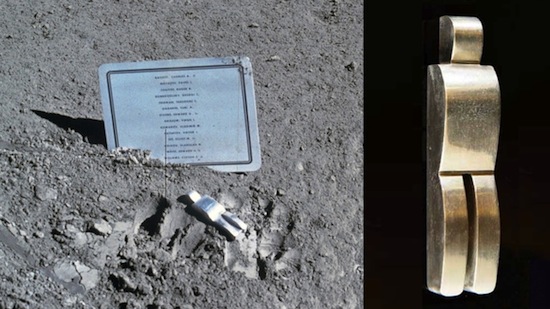
This monument was erected by David Scott, the commander of Apollo 15, on the ground, next to the chassis of the moon car, near the furrow of Hadley ( Hadley Rille ), not far from the crater of Bela .
')

Jim Irwin and the LRV moonmobile from Apollo 15, with the Mons Hadley mountains in the background

Bela Crater
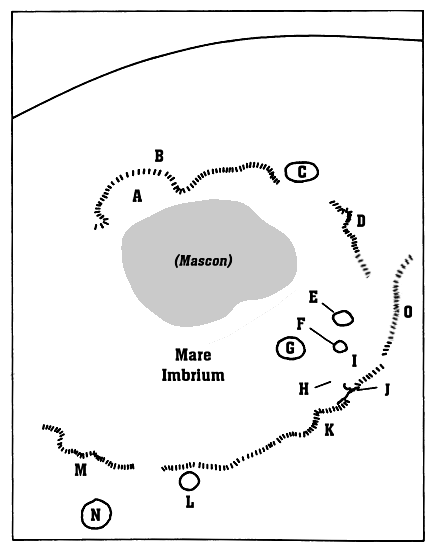
Map of the Sea of Rains, (I) - Headley Fissure
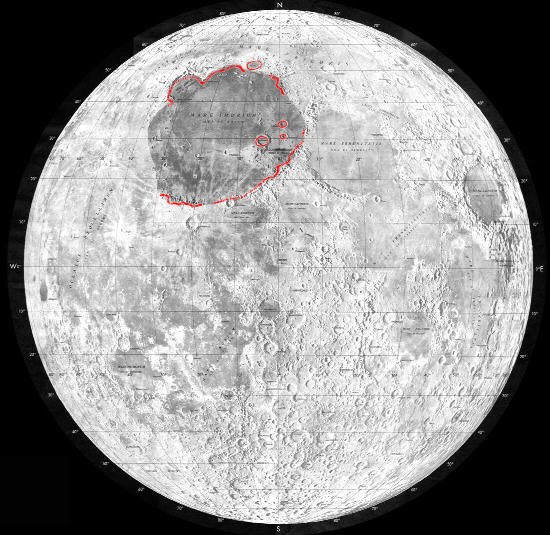
General view of the Sea of Rains
The sculpture was created, on the personal initiative and request of David Scott, by the Belgian artist Paul Van Hoeydonck (Paul Van Heydonkom), with whom astronaut David Scott met at a dinner party. Van Heidonku was asked to create a small statuette in memory of those astronauts and astronauts who gave their lives for the cause of space exploration.
Van Haydonku was given a set of design constraints:
By agreement with Scott, in order to avoid the commercialization of space, the author’s name, Van Heydonka, was to be kept secret.
Next to the statuette was a plaque on which the names of eight American astronauts and six Soviet cosmonauts were engraved.
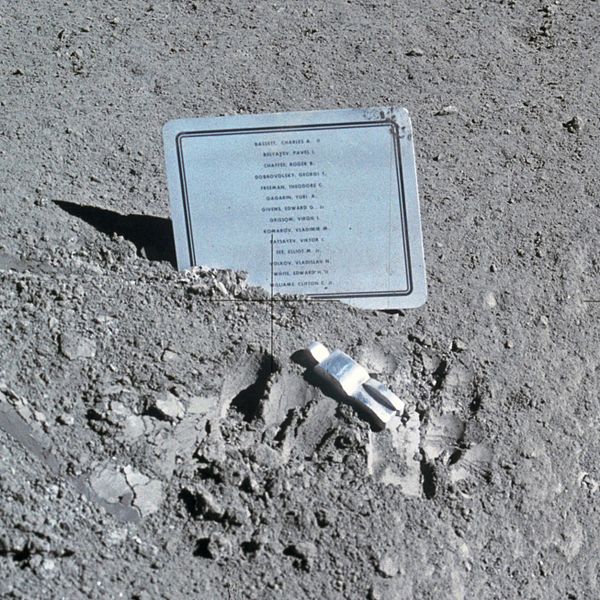
Clickable
Later, David Scott regretted that the names of Valentin Bondarenko and Grigory Nelyubov were missing on the tablet. He explained that because of the secrecy around the Soviet space program at the time, they did not know about their death.
After the team mentioned the statuette during the post-flight press conference, the National Museum of Aviation and Astronautics asked for a cue for public viewing. The crew agreed, on condition that it would be shown “with good taste and without publicity”. One remark was handed over to the Smithsonian Institution and on April 17, 1972, the day after CBS, presenter Walter Cronkite showed it during a broadcast from Apollo 16 and declared the existence of a “Fallen Astronaut” and a memorial plaque as the first art installation on the moon. Currently, a replica of the figurine with a copy of the memorial plaque is in the National Museum of Aviation and Cosmonautics (National Building Mall) in the wing of the Space Race, Gallery 114.
In May 1972, Scott learned that Van Heidonkom planned to make several replicas for their subsequent sale. Believing that this would be a violation of their agreement, Scott tried to convince Van Heidonka to refrain from this idea. This event was widely advertised in the media and took up a whole page of advertising in the July magazine “Art in America” for 1972. The ad said that 950 copies of the Fallen Astronaut, signed by the sculptor, will be sold in one of the New York galleries (Waddell Gallery of New York) for $ 750 each; the second replica - at a lower price (as yet uncertain); and a special catalog edition of $ 5.
Following the negative comments from NASA about the proposed sale, Van Heydonk refused his decision and the statues were not sold.
In a letter written in September 2007, Van Heidonka wrote that 50 copies were nevertheless made and that most of them are still in his possession, without an author's signature. Van Heidonka also wrote that, with the exception of one copy, he never received money for the statues of "Fallen Astronaut", despite the numerous purchase offers he received.
Van Heydonka recalls another set of events leading up to the artifact. According to an interview with him in the Belgian newspaper Le Soir, the statue was supposed to be the personification of all of humanity, and not just a fallen astronaut or cosmonaut. He stated that he did not know that the statue would be used as a memorial to the fallen conquerors of space.
It is worth noting that the USA also honored the role of the Soviet Astronauts in space exploration on the Apollo 11 expedition and brought the flag of the USSR, which was on the Moon, to Earth.
During the landing of the Apollo 11 on the moon, small flags of more than 130 countries were taken on board. Among them was the flag of the USSR.
On June 2, 1970, at a meeting with Chairman of the USSR Council of Ministers Alexei Kosygin, Neil Armstrong presented him with a small container with samples of lunar soil and the flag of the USSR, which, together with astronauts, on July 20-21, 1969, visited the surface of the Moon. Kosygin said that he will always take care of this gift as a symbol of great achievement.
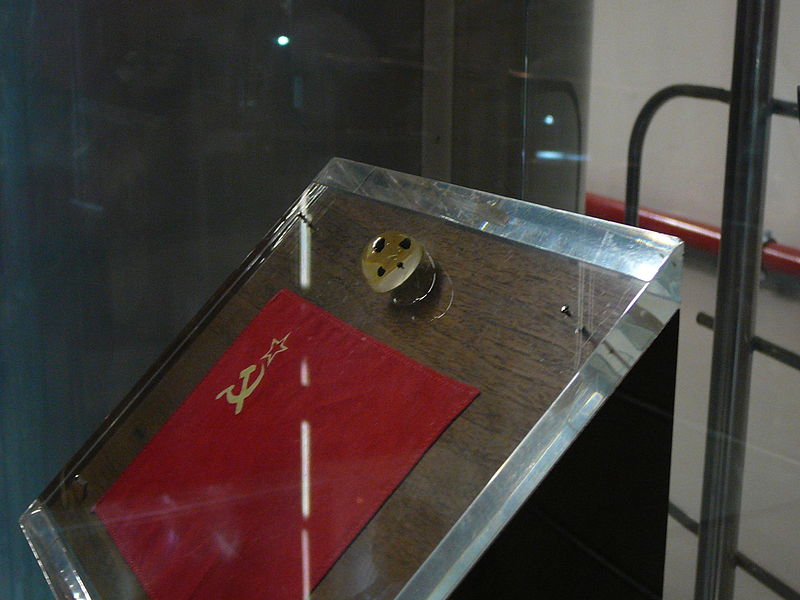
The USSR flag, which visited the Moon aboard the Orla, and a little higher, is a container with lunar soil brought by Apollo 11 and donated to the Soviet Union by Americans on display at the Memorial Museum of Astronautics at the VDNKh metro station in Moscow.
Now, on the threshold of colonization of the Moon and Mars, against the background of a renewed space race and discourse on the advantages of a political system, I want to draw attention to the silent feat of those who are at the last instance of using high-tech machines and mechanisms, on living cosmonauts and astronauts - simple heroes who take upon themselves the brunt of the black abyss when the latest electronics fails and titanium burns. It is they who pave the way for the stars. And we remember them much less often than they deserve. They say the pilots of the aircraft even treat astronauts with condescension or even hostility, saying that the automatics and robots do everything for the cosmonauts, and the cosmonaut is only an observer, an extra. It is not right.
In conclusion, I want to cite an excerpt from an article from the journal Science and Technology on April 12, 2002.
... When B. Volynov landed, the descent vehicle could not be oriented correctly, i.e. Install heat with a protective screen in the direction of movement. He entered the atmosphere and began to burn. V. Kovalenko and A. Ivanchenkov, who were part of the ground control team, still managed to deploy the ship and prevent disaster.
During the launch of cosmonauts V. Lazarev and O. Makarov, the rocket crashed. Fortunately, the emergency rescue system worked flawlessly. With a huge overload of 22 units, she tore off a spacecraft from a rocket, threw it along a ballistic trajectory and lowered it in the mountains on the edge of a cliff.
On October 16, 1976, the cosmonauts V.Rozhdestvensky and V.Zudov were forced to make an emergency landing on the Soyuz-23 spacecraft after 2 days of flight. At the same time, they landed on the surface of a lake covered with pieces of ice at an ambient temperature of –22 ° C. But failures continued to haunt them here. In the water there was shooting the reserve parachute cap. He came out of the compartment, getting wet, turned the ship over and started dragging him to the bottom. The astronauts were found and pulled out only after 11 hours, when they were already suffocating from the lack of air.
On April 20, 1983, during the flight on the Soyuz T-8 spacecraft, astronauts V. Titov, G. Strekalov and A. Serebrov (not to be confused with G. Titov who made a daily flight on the Vostok ship on 6.8.1961) did not left docking system antenna bar. All their attempts to dock with the ship "Salyut-7" ended in failure. After 2 days of flight, they returned without completing the task. Two months later, on 06/27/83, V. Lyakhov and Alexandrov were sent instead of them on the Soyuz T-9 spacecraft.
In a new flight, V. Titov and G. Strekalov were to leave on September 26, 1983, at 23 hours 37 minutes. A few seconds before the launch, the rocket caught fire. At first, they could not even understand what had happened, assuming that the engines started up prematurely. But the emergency system of rescuing astronauts here worked flawlessly. Just a moment before the explosion, she pulled out a ship from the flame and landed him 4 km from the launch site. Seeing the sea of fire at the site of the launch complex, the astronauts did not even immediately understand what had happened.
Only from the third attempt did V. Titov manage to climb into space.
Emergency situations during the flight of the ships "Soyuz-10" (start 23.4.71, cosmonauts V. Shatalov, A. Eliseev, N. Rukavishnikov), "Soyuz-25" (5.6.80, Yu. Malyshev, V. Aksenov), as well as when launching the satellites Cosmos-954, Cosmos-1402, Cosmos-1900, the Salyut-7 station and other spacecraft.
During the flight of V. Lyakhov and V. Ryumin (Soyuz-32, launch 25.2.79), they had to go into space in order to cut the confused cable of the satellite radio telescope antenna and save the station.
On April 10, 1979, during the Soyuz-33 flight, after the launch into orbit, the main engine of the spacecraft exploded. The flight had to be interrupted, especially since the Bulgarian Georgy Ivanov was on board as a co-pilot. Fortunately, the spare engine worked and the astronauts managed to return to the ground.
During the 1985 flight, astronaut Vasyutin became seriously ill. However, this case, as usual, was hidden even from world science.
Young people, dream and become astronauts. Do not you go to managers, economists, etc.
There are no wars and corruption in the modern world of a more worthy goal than a goal to get a star and give it to humanity.)
Maybe that star will save the world.
Well, forgive me if I hurt a “star” just a good person, I did not want to.)
This information appeared on the network several times in October 2012, in February of the current one, but probably was left without proper attention. I myself personally saw her for the first time today, in one of the LJ posts.
According to the rules of Habr, it is strongly discouraged to post reposts, so I will turn to the original English text of the article, which was posted on En.Wikipedia in March 2010. And since there is a young Hub “Cosmonautics” on Habré, where this article should necessarily be, I will present, so to speak, her own statement and with due respect.
The fallen Astronaut is an aluminum (figurine) sculpture of an astronaut in a spacesuit, eight and a half cm tall (just over 3 "), created in memory of astronauts and astronauts who died on the difficult path of space exploration. The monument is installed by the Apollo 15 crew in the Sea of Rains on Luna, August 1, 1971

This monument was erected by David Scott, the commander of Apollo 15, on the ground, next to the chassis of the moon car, near the furrow of Hadley ( Hadley Rille ), not far from the crater of Bela .
')

Jim Irwin and the LRV moonmobile from Apollo 15, with the Mons Hadley mountains in the background

Bela Crater

Map of the Sea of Rains, (I) - Headley Fissure

General view of the Sea of Rains
Story
The sculpture was created, on the personal initiative and request of David Scott, by the Belgian artist Paul Van Hoeydonck (Paul Van Heydonkom), with whom astronaut David Scott met at a dinner party. Van Heidonku was asked to create a small statuette in memory of those astronauts and astronauts who gave their lives for the cause of space exploration.
Van Haydonku was given a set of design constraints:
- the sculpture was supposed to be light and durable;
- able to withstand the extreme temperatures of the moon;
- must be sexless, she cannot be recognized as male or female;
- and no particular ethnic group.
By agreement with Scott, in order to avoid the commercialization of space, the author’s name, Van Heydonka, was to be kept secret.
Next to the statuette was a plaque on which the names of eight American astronauts and six Soviet cosmonauts were engraved.
- Charles Bassett (February 28, 1966, plane crash)
- Pavel Belyaev (January 10, 1970, due to illness)
- Roger Chaffee (January 27, 1967, Apollo 1, fire)
- Georgy Dobrovolsky (June 30, 1971, Union-11, depressurization of the descent vehicle)
- Theodore Freeman (October 31, 1964, plane crash)
- Yuri Gagarin (March 27, 1968, plane crash)
- Edward Givens (June 6, 1967, car accident)
- Gus Grissom (January 27, 1967, Apollo 1, fire)
- Vladimir Komarov (April 24, 1967, Soyuz-1, failure of the parachute system)
- Victor Patsayev (June 30, 1971, Union-11, depressurization of the descent vehicle)
- Elliot C (February 28, 1966, plane crash)
- Vladislav Volkov (June 30, 1971, Union-11, depressurization of the descent vehicle)
- Edward White (January 27, 1967, Apollo 1, fire)
- Clifton Williams (October 5, 1967 plane crash)

Clickable
Later, David Scott regretted that the names of Valentin Bondarenko and Grigory Nelyubov were missing on the tablet. He explained that because of the secrecy around the Soviet space program at the time, they did not know about their death.
Effects
After the team mentioned the statuette during the post-flight press conference, the National Museum of Aviation and Astronautics asked for a cue for public viewing. The crew agreed, on condition that it would be shown “with good taste and without publicity”. One remark was handed over to the Smithsonian Institution and on April 17, 1972, the day after CBS, presenter Walter Cronkite showed it during a broadcast from Apollo 16 and declared the existence of a “Fallen Astronaut” and a memorial plaque as the first art installation on the moon. Currently, a replica of the figurine with a copy of the memorial plaque is in the National Museum of Aviation and Cosmonautics (National Building Mall) in the wing of the Space Race, Gallery 114.
In May 1972, Scott learned that Van Heidonkom planned to make several replicas for their subsequent sale. Believing that this would be a violation of their agreement, Scott tried to convince Van Heidonka to refrain from this idea. This event was widely advertised in the media and took up a whole page of advertising in the July magazine “Art in America” for 1972. The ad said that 950 copies of the Fallen Astronaut, signed by the sculptor, will be sold in one of the New York galleries (Waddell Gallery of New York) for $ 750 each; the second replica - at a lower price (as yet uncertain); and a special catalog edition of $ 5.
Following the negative comments from NASA about the proposed sale, Van Heydonk refused his decision and the statues were not sold.
In a letter written in September 2007, Van Heidonka wrote that 50 copies were nevertheless made and that most of them are still in his possession, without an author's signature. Van Heidonka also wrote that, with the exception of one copy, he never received money for the statues of "Fallen Astronaut", despite the numerous purchase offers he received.
Van Heydonka recalls another set of events leading up to the artifact. According to an interview with him in the Belgian newspaper Le Soir, the statue was supposed to be the personification of all of humanity, and not just a fallen astronaut or cosmonaut. He stated that he did not know that the statue would be used as a memorial to the fallen conquerors of space.
It is worth noting that the USA also honored the role of the Soviet Astronauts in space exploration on the Apollo 11 expedition and brought the flag of the USSR, which was on the Moon, to Earth.
During the landing of the Apollo 11 on the moon, small flags of more than 130 countries were taken on board. Among them was the flag of the USSR.
On June 2, 1970, at a meeting with Chairman of the USSR Council of Ministers Alexei Kosygin, Neil Armstrong presented him with a small container with samples of lunar soil and the flag of the USSR, which, together with astronauts, on July 20-21, 1969, visited the surface of the Moon. Kosygin said that he will always take care of this gift as a symbol of great achievement.

The USSR flag, which visited the Moon aboard the Orla, and a little higher, is a container with lunar soil brought by Apollo 11 and donated to the Soviet Union by Americans on display at the Memorial Museum of Astronautics at the VDNKh metro station in Moscow.
Epilogue
Now, on the threshold of colonization of the Moon and Mars, against the background of a renewed space race and discourse on the advantages of a political system, I want to draw attention to the silent feat of those who are at the last instance of using high-tech machines and mechanisms, on living cosmonauts and astronauts - simple heroes who take upon themselves the brunt of the black abyss when the latest electronics fails and titanium burns. It is they who pave the way for the stars. And we remember them much less often than they deserve. They say the pilots of the aircraft even treat astronauts with condescension or even hostility, saying that the automatics and robots do everything for the cosmonauts, and the cosmonaut is only an observer, an extra. It is not right.
In conclusion, I want to cite an excerpt from an article from the journal Science and Technology on April 12, 2002.
... When B. Volynov landed, the descent vehicle could not be oriented correctly, i.e. Install heat with a protective screen in the direction of movement. He entered the atmosphere and began to burn. V. Kovalenko and A. Ivanchenkov, who were part of the ground control team, still managed to deploy the ship and prevent disaster.
During the launch of cosmonauts V. Lazarev and O. Makarov, the rocket crashed. Fortunately, the emergency rescue system worked flawlessly. With a huge overload of 22 units, she tore off a spacecraft from a rocket, threw it along a ballistic trajectory and lowered it in the mountains on the edge of a cliff.
On October 16, 1976, the cosmonauts V.Rozhdestvensky and V.Zudov were forced to make an emergency landing on the Soyuz-23 spacecraft after 2 days of flight. At the same time, they landed on the surface of a lake covered with pieces of ice at an ambient temperature of –22 ° C. But failures continued to haunt them here. In the water there was shooting the reserve parachute cap. He came out of the compartment, getting wet, turned the ship over and started dragging him to the bottom. The astronauts were found and pulled out only after 11 hours, when they were already suffocating from the lack of air.
On April 20, 1983, during the flight on the Soyuz T-8 spacecraft, astronauts V. Titov, G. Strekalov and A. Serebrov (not to be confused with G. Titov who made a daily flight on the Vostok ship on 6.8.1961) did not left docking system antenna bar. All their attempts to dock with the ship "Salyut-7" ended in failure. After 2 days of flight, they returned without completing the task. Two months later, on 06/27/83, V. Lyakhov and Alexandrov were sent instead of them on the Soyuz T-9 spacecraft.
In a new flight, V. Titov and G. Strekalov were to leave on September 26, 1983, at 23 hours 37 minutes. A few seconds before the launch, the rocket caught fire. At first, they could not even understand what had happened, assuming that the engines started up prematurely. But the emergency system of rescuing astronauts here worked flawlessly. Just a moment before the explosion, she pulled out a ship from the flame and landed him 4 km from the launch site. Seeing the sea of fire at the site of the launch complex, the astronauts did not even immediately understand what had happened.
Only from the third attempt did V. Titov manage to climb into space.
Emergency situations during the flight of the ships "Soyuz-10" (start 23.4.71, cosmonauts V. Shatalov, A. Eliseev, N. Rukavishnikov), "Soyuz-25" (5.6.80, Yu. Malyshev, V. Aksenov), as well as when launching the satellites Cosmos-954, Cosmos-1402, Cosmos-1900, the Salyut-7 station and other spacecraft.
During the flight of V. Lyakhov and V. Ryumin (Soyuz-32, launch 25.2.79), they had to go into space in order to cut the confused cable of the satellite radio telescope antenna and save the station.
On April 10, 1979, during the Soyuz-33 flight, after the launch into orbit, the main engine of the spacecraft exploded. The flight had to be interrupted, especially since the Bulgarian Georgy Ivanov was on board as a co-pilot. Fortunately, the spare engine worked and the astronauts managed to return to the ground.
During the 1985 flight, astronaut Vasyutin became seriously ill. However, this case, as usual, was hidden even from world science.
Young people, dream and become astronauts. Do not you go to managers, economists, etc.
There are no wars and corruption in the modern world of a more worthy goal than a goal to get a star and give it to humanity.)
Maybe that star will save the world.
Well, forgive me if I hurt a “star” just a good person, I did not want to.)
Source: https://habr.com/ru/post/187744/
All Articles